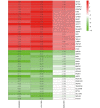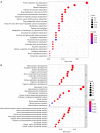Bioinformatics analysis and identification of genes and pathways involved in patients with Wilms tumor
- PMID: 36093523
- PMCID: PMC9459508
- DOI: 10.21037/tcr-22-1847
Bioinformatics analysis and identification of genes and pathways involved in patients with Wilms tumor
Abstract
Background: Wilms tumor is the most common childhood kidney malignant tumor. However, the genes and signaling pathways associated with the disease remain incompletely understood.
Methods: GSE66405, GSE73209, and GSE11151 were collected from the Gene Expression Omnibus (GEO) database, and differentially expressed genes (DEGs) were detected using R software. A protein-protein interaction (PPI) network was constructed using the STRING database, and the clustering modules and hub genes were analyzed with the Cytoscape software. Genes functional enrichment analyses were performed using the package "clusterProfiler" in R software, and the gene set enrichment analysis (GSEA) analysis was performed using GSEA v4.1.0 software.
Results: Respectively, 3,092, 620, and 3,567 DEGs were screened in GSE66405, GSE73209, and GSE11151, with a total of 474 common DEGs detected in three expression profiles. For the common DEGs, the top 30 significant results of Gene Ontology (GO) and Kyoto Encyclopedia of Genes and Genomes (KEGG) pathways enrichment analyses were presented. Furthermore, five modules were found as the most related modules to Wilms tumor. GO term and KEGG pathway enrichment analyses of the genes in all the modules identified 10 GO terms and 5 KEGG pathways as significantly enriched. The top 10 hub DEGs of the PPI network were ALB, CDH1, EGF, AQP2, REN, SLC2A2, SPP1, UMOD, NPHS2, and FOXM1, with ALB identified as the highest degree. GSEA results showed 11 pathways were correlated with ALB expression in GSE66405 and 10 pathways were related to the expression of the ALB gene in GSE73209.
Conclusions: Our study revealed robust gene signatures in Wilms tumor. Dysregulations of the signaling pathways were associated with the development and progression of the Wilms tumor, and 10 hub genes may play important roles in its diagnosis and therapy.
Keywords: Wilms tumor; differentially expressed genes (DEGs); hub genes; pathways.
2022 Translational Cancer Research. All rights reserved.
Conflict of interest statement
Conflicts of Interest: All authors have completed the ICMJE uniform disclosure form (available at https://tcr.amegroups.com/article/view/10.21037/tcr-22-1847/coif). The authors have no conflicts of interest to declare.
Figures









References
-
- Gooskens SL, Segers H, Pritchard-Jones K, et al. The Clinical Relevance of Age at Presentation in Nephroblastoma 2016. - PubMed
LinkOut - more resources
Full Text Sources
Research Materials
Miscellaneous
